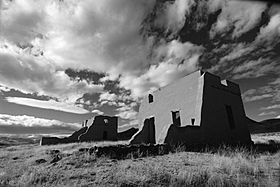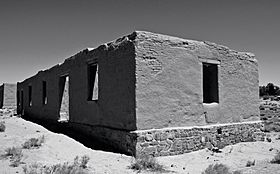Fort Churchill State Historic Park facts for kids
Quick facts for kids Fort Churchill State Historic Park |
|
|---|---|
 |
|
| Lua error in Module:Location_map at line 420: attempt to index field 'wikibase' (a nil value). | |
| Location | Lyon County, Nevada, United States |
| Nearest city | Silver Springs, Nevada |
| Area | 5,170.24 acres (2,092.32 ha) |
| Elevation | 4,255 ft (1,297 m) |
| Established | 1957 |
| Administered by | Nevada Division of State Parks |
| Visitors | 16,886 vehicles (in 2017) |
| Designation | Nevada state historic park |
|
Fort Churchill
|
|

Ruins at Fort Churchill State Historic Park
|
|
| Location | Lyon County, Nevada, United States |
| Nearest city | Silver Springs, Nevada |
| Area | 20 acres (8.1 ha) |
| Built | 1860 |
| Architect | Captain Joseph Stewart, Captain F. F. Flint |
| NRHP reference No. | 66000456 |
| Significant dates | |
| Added to NRHP | October 15, 1966 |
| Designated NHL | November 5, 1961 |
Fort Churchill State Historic Park is a special place in Nevada, United States. It protects the old buildings of a United States Army fort. It also includes a stop for the Pony Express and the Central Overland Route from the 1860s. This park is located in Lyon County, south of Silver Springs. It's about 8 miles south of US Route 50 on US Route 95 Alternate. Fort Churchill was named a National Historic Landmark in 1961. A part of the park added in 1994 follows the Carson River.
Contents
Fort Churchill
Why Fort Churchill Was Built
In 1860, a serious conflict began at Williams Station along the Carson River. This led to what was called the Pyramid Lake War. After some fighting, Captain Joseph Stewart decided to build a permanent US Army fort. This fort was placed along the Carson River, close to where the conflict started.
The new post was named Fort Churchill. It honored Sylvester Churchill, who was an Inspector General for the US Army. Building the fort started on July 20, 1860, and it was finished in 1861. Its main job was to keep early settlers safe. It also protected the important mail route used by the Pony Express.
During the American Civil War, Fort Churchill became a key place for supplies for the Union Army. Around 200 soldiers usually lived there. However, the fort was closed down in 1869. This was four years after the Civil War ended. The empty buildings were later sold at an auction for $750.
Becoming a State Park
On October 6, 1932, the state of Nevada took control of 200 acres of the fort's land. A few years later, in 1934, the property was given to a local group called the Daughters of the American Revolution. With help from the National Park Service, the fort's ruins were partly fixed up. They were kept in a state of "arrested decay," meaning they were preserved as ruins. The Civilian Conservation Corps also built the visitor center you see today.
In 1957, Fort Churchill officially became part of Nevada's state park system. It was recognized as a National Historic Landmark in 1961. Then, in 1966, it was added to the National Register of Historic Places.
Exploring the Carson River Ranches
In 1994, the state park service bought 3,200 acres of land along the Carson River. This area is east of the fort and Buckland Station. This land creates a natural pathway that connects Fort Churchill to Lahontan State Recreation Area. It's a home for many different plants and animals. People love to visit this area for camping, hiking, watching birds, canoeing, hunting, and horseback riding.
Buckland Station: A Historic Stop
Samuel S. Buckland arrived in this area in 1859 to start his ranch. His ranch became a very important stop along the Central Overland Route. The Pony Express also used his ranch to change horses. When Fort Churchill was closed and taken apart, Buckland used some of the materials to build the two-story building you can see today. In 1997, the state park added Buckland Station to the Fort Churchill State Historic Site.
What to Do at the Park
The visitor center at Fort Churchill has cool exhibits. You can learn about the fort's history, the Native American people who lived here, and the nature around the park.
There's a campground with 20 sites along the Carson River. It's nestled among cottonwood trees. There are also areas for group camping and picnics. Another simple camp is located further along the Carson River in the Carson River Ranches area.
You can enjoy hiking trails, including a self-guided path around the fort ruins. Signs along the way explain what each building was used for. The Orchard Trail follows the Carson River from the campground to Buckland Station. This trail continues through the Carson River Ranches unit.
Sometimes, groups like the Nevada Civil War Volunteers hold special events. They put on a Civil War encampment at Fort Churchill, showing what life was like back then.
See also
- List of National Historic Landmarks in Nevada
- National Register of Historic Places listings in Lyon County, Nevada
- List of the oldest buildings in Nevada

